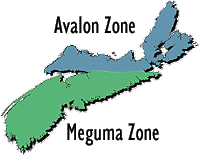    |
| Ordovician Period Time of Fish (505-438 mya) |
| Global View - Where was Nova Scotia?
At this time the Avalon Zone was part of the northern European subcontinent called Avalonia. In the Early Ordovician, this landmass was far south of the equator. Rocks of Nova Scotia At the beginning of Ordovician time, volcanoes were active in the Avalon Zone, spreading their debris over the land and shallow seas of Cape Breton Island and the Antigonish Highlands. Late Ordovician volcanic rocks can be found at Arisaig. These units are over 80 m (262 ft) thick and consist of dark green basaltic lava flows overlain by orange-red felsic lava flows (rhyolites), felsic ash flows and tuffs. The basalts show columnar jointing and gas cavities either filled (amygdules) or open (vesicles) at the tops and bottoms of the flows. Red to purple gravelly layers occur between the basaltic lava flows and are interpreted as ancient soils which developed between volcanic eruptions. In the Meguma Zone, turbidity flows transported large volumes of sediment from the continental shelf of the African continental plate to the depositional area of the Meguma Group. These deposits are represented by the thick, uniform sandstones of the Goldenville Formation and are overlain by slates of the Halifax Formation. More than two million cubic kilometres (480000 cubic miles) of sediment were deposited in the Meguma Zone, but fossils in these rocks are rare, indicating that the environment was cold and hostile. At the close of the Ordovician Period, the White Rock Formation was deposited on top of the Halifax Formation. Paleoenvironment Fossils in the rocks of the Meguma Zone are rare, indicating that the environment, which varied between shallow and deep water, was cold and hostile. The climate, however, may have been warm to hot. The heat of lava often burned away any organic material which might otherwise have been fossilised. Therefore, the rocks of the Avalon Zone have left scientists very few clues about the paleoenvironment at this time. |
 The two zones of Nova
Scotia were widely separated during the Ordovician Period. The Meguma Zone possibly lay
south of the equator in Gondwanaland, offshore of what is present day northern Africa. The
sand grains in the Goldenville Formation would have eroded from the Saharan Precambrian
Shield.
The two zones of Nova
Scotia were widely separated during the Ordovician Period. The Meguma Zone possibly lay
south of the equator in Gondwanaland, offshore of what is present day northern Africa. The
sand grains in the Goldenville Formation would have eroded from the Saharan Precambrian
Shield.